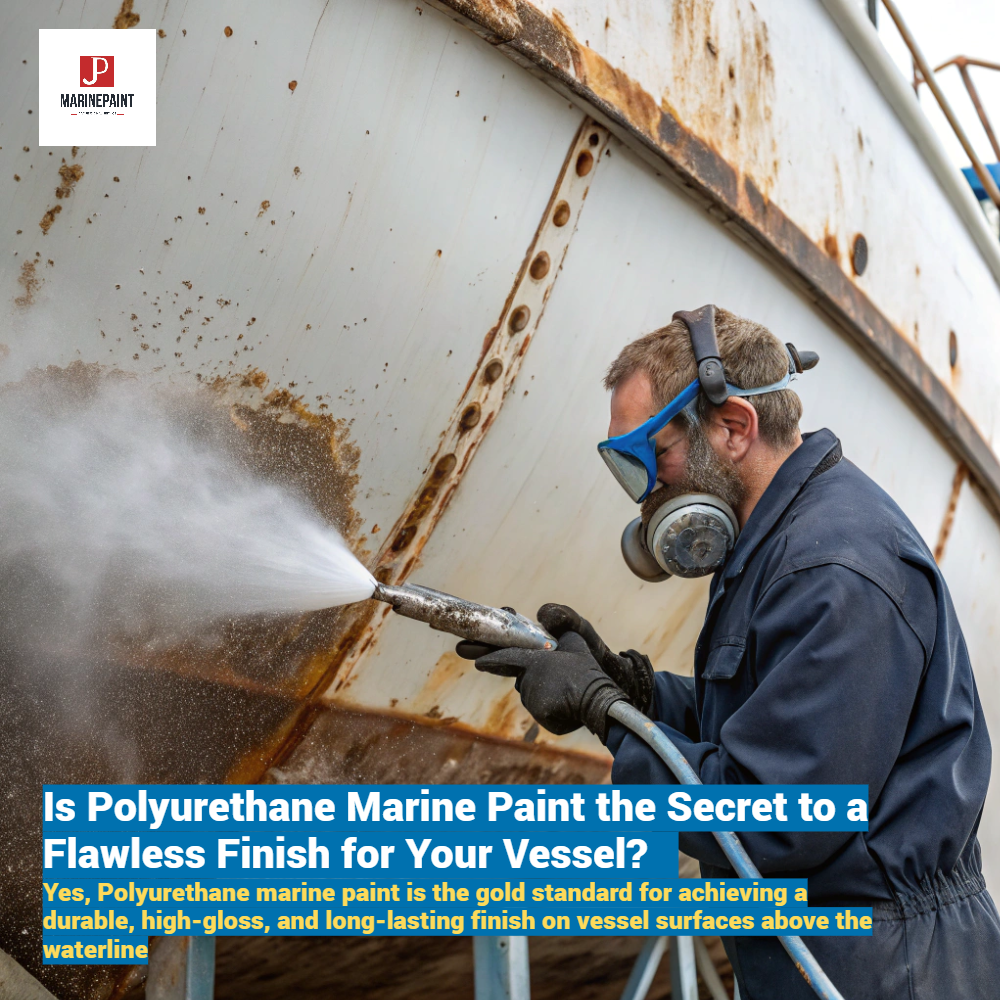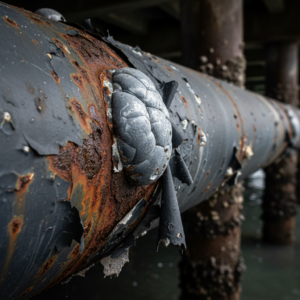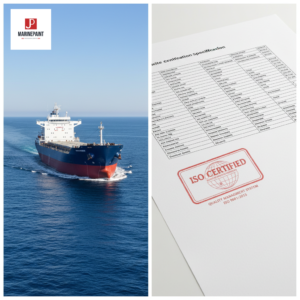Polyurethane Marine Paint: A Guide to a Flawless Finish
The harsh marine environment relentlessly attacks your vessel's finish. Salt, sun, and wear cause fading and damage, but polyurethane marine paint offers the ultimate protection and a brilliant shine.
Yes, polyurethane marine paint is the gold standard for achieving a durable, high-gloss, and long-lasting finish on vessel surfaces above the waterline [4, 7]. This high-performance topcoat, often an acrylic polyurethane, is chemically engineered to form an incredibly hard, protective film that provides a beautiful aesthetic [20, 26]. Its primary purpose is to deliver a finish that not only looks stunning but also offers robust resistance to the most challenging marine conditions. This guide will walk you through its benefits, the differences between paint systems, the critical role of primers, and the correct surface preparation needed to ensure your investment protects and beautifies your vessel for years to come. This is the professional's choice for protecting hulls, decks, and superstructures from UV degradation, chemical spills, and abrasion [3, 4, 7].
![[Image Placeholder]> Prompt: A stunning, high-gloss finish on the hull of a luxury yacht sailing on clear blue water, with the sun reflecting off the flawless polyurethane marine paint. [Image Placeholder]> Prompt: A stunning, high-gloss finish on the hull of a luxury yacht sailing on clear blue water, with the sun reflecting off the flawless polyurethane marine paint.](https://jdmarinepaint.com/wp-content/uploads/2025/07/a-stunning-high-gloss-finish-on-the-hull-of-a-lux-2.png)
Choosing the right paint is one of the most important decisions you'll make in marine maintenance. To help you make an informed choice, let's dive deeper into what makes this protective coating the best-in-class solution for your boat.
Why Choose Polyurethane Marine Paint? Key Properties and Advantages?
Problem: Standard marine paints often can't withstand the constant assault of intense sun and corrosive saltwater. Agitate: This leads to them quickly fading, yellowing, chalking, and chipping. Your vessel starts to look worn and poorly maintained, which not only diminishes your pride of ownership but can also decrease its value and lead to frequent, costly, and labor-intensive repainting cycles. Solution: A quality polyurethane marine paint system is chemically engineered to overcome these challenges, providing unparalleled long-term protection and aesthetics that keep your vessel looking pristine season after season.
A high-performance polyurethane topcoat delivers a suite of benefits that are essential for marine applications. Its formulation provides superior resistance to the elements, ensuring your vessel maintains its value and appearance. The primary advantages lie in its exceptional durability, aesthetic quality, and protective capabilities. When you choose a quality polyurethane, you're investing in a shield that preserves both the look and the integrity of your boat's surfaces.
Key Advantages of a Polyurethane System
A premium polyurethane marine paint system offers benefits that go far beyond a simple color change. It creates a robust barrier that actively preserves your vessel.
- Superior UV Resistance & Non-Yellowing Properties: One of the greatest threats to a boat's finish is constant sun exposure. Polyurethane formulations are designed with powerful UV inhibitors that prevent the paint from breaking down, fading, or yellowing over time [1, 26]. Products like our JD918 Acrylic Polyurethane Hull Paint (Yellowing resistance) are specifically engineered for excellent weather and color retention, even in the most intense sunlight [1, 26].
- Exceptional Gloss and Color Retention: Polyurethane topcoats are famous for their deep, "wet look" gloss that lasts for years [20, 26]. Unlike other paints that can dull quickly, a product such as JD908 Acrylic Polyurethane Topcoat Non-Yellowing Resistant maintains its vibrant color and high-gloss finish, keeping your vessel looking freshly painted [20, 26].
- Incredible Durability and Flexibility: The coating cures to a hard yet flexible film that resists abrasion, scratches, and impacts from docking, gear, and daily use [3, 4]. This toughness protects the underlying structure and reduces the need for frequent touch-ups.
- Excellent Chemical and Saltwater Resistance: From corrosive salt spray to accidental fuel or oil spills, a polyurethane finish provides a strong defense. It creates an impermeable barrier that withstands common chemicals, ensuring the coating doesn't stain, soften, or fail [6, 26].
One-Part vs. Two-Part Polyurethane Marine Paint: Which is Right for You?
Problem: You've decided on the superior protection of polyurethane marine paint, but now you're faced with a choice: a one-part or two-part system? Agitate: Making the wrong choice can be frustrating. You might end up with a finish that isn't as durable as you hoped, or you could find yourself struggling with a complex application process that feels overwhelming, potentially wasting your time, effort, and money on a subpar result. Solution: Understanding the fundamental differences between these two systems is key to selecting the perfect paint for your specific project, skill level, and durability requirements.
The choice between a one-part and a two-part (or two-pack) polyurethane paint depends largely on your project's demands for durability and your comfort level with the application process. One-part polyurethanes are alkyd-based and cure by reacting with moisture in the air. They are generally more user-friendly and forgiving, making them a great option for DIY enthusiasts or for smaller projects and touch-ups. Two-part systems, however, are the professional standard for good reason. They offer a level of hardness and longevity that single-part paints cannot match.
Understanding the Systems
To make the best decision, it's helpful to compare the two systems directly.
One-Part Polyurethane: Simplicity and Convenience
This type of boat paint is ideal for boaters who prioritize ease of use. It comes ready to apply straight from the can, without the need for precise mixing. While not as tough as its two-part counterpart, a quality one-part polyurethane still offers good gloss, UV protection, and flexibility, making it suitable for decks, trim, and smaller boats where application simplicity is a priority.
Two-Part Polyurethane: The Professional's Choice for Durability
Two-part acrylic polyurethane systems are the pinnacle of marine coatings technology [20, 26]. They consist of a base resin (Part A) and a chemical hardener or activator (Part B) that, when mixed, initiate a chemical reaction [12, 26]. This cross-linking process creates a finish that is significantly harder, more chemically resistant, and more durable than any one-part paint. Our professional-grade systems, like JD908 and JD918, use a precise mixing ratio (e.g., 20:3 by weight) to achieve maximum performance, delivering a finish that can withstand the harshest offshore environments [12, 26].
| Feature | One-Part Polyurethane | Two-Part Polyurethane |
|---|---|---|
| Composition | Single component, cures with air/moisture | Two components (Base + Hardener), cures chemically [12, 26] |
| Durability | Good | Exceptional (Superior hardness & abrasion resistance) |
| Ease of Use | Very Easy (No mixing required) | Moderate (Requires precise mixing and has a pot life) [7, 26] |
| Gloss & Color Retention | Good | Excellent (Longest lasting shine and color) [20, 26] |
| Chemical Resistance | Moderate | Excellent (Resists fuel, oil, and harsh cleaners) [6, 26] |
| Ideal For | DIY projects, touch-ups, trim work | Professional applications, hull & superstructure, high-wear areas [4, 7] |
Do You Need an Epoxy Primer with Polyurethane Marine Paint for Maximum Protection?
Problem: You're ready to invest in a top-quality polyurethane marine paint for that brilliant, long-lasting shine. Agitate: But applying that beautiful topcoat directly to bare steel or an improperly prepared surface is a recipe for failure. Without the right foundation, you risk poor adhesion, which leads to catastrophic peeling, blistering, and hidden corrosion that can compromise the integrity of your vessel's structure, forcing you to start the entire costly process all over again. Solution: The secret to a truly professional and durable paint job isn't just the topcoat; it's the complete system, starting with a high-performance epoxy primer.
Absolutely. For maximum protection and longevity, professionals always use a multi-paint system, and the combination of an epoxy primer with a polyurethane topcoat is the undisputed champion. These two coatings work together in synergy, where each performs a function the other cannot. An epoxy primer creates the tenacious bond and anti-corrosive barrier, while the polyurethane topcoat provides the aesthetic beauty and environmental protection. Attempting to use a polyurethane topcoat without a proper primer foundation, especially on metal surfaces, will severely compromise the paint job's lifespan.
The Unbeatable Two-Step System
Think of it as building a house: you can't have a strong structure without a solid foundation. In marine painting, epoxy is that foundation.
The Role of the Epoxy Primer: Adhesion and Corrosion Protection
Epoxy primers are engineered for one primary purpose: to bond tenaciously to the substrate and provide a rock-solid, anti-corrosive barrier [14]. Products like our JDH815 Iron Oxide Red Epoxy Primer form a waterproof shield that prevents moisture from reaching the steel, effectively stopping rust before it can start [4, 9]. Epoxies have incredible adhesion but are not UV stable; they will chalk and degrade in direct sunlight. This is why they must be top-coated. For surfaces that are difficult to prepare perfectly, a surface-tolerant primer like JDH818 Rough Surface Epoxy Primer can provide excellent adhesion even in less-than-ideal conditions [3, 11].
The Role of the Polyurethane Topcoat: The Finishing Shield
This is where the polyurethane marine paint comes in. It is applied over the fully cured and sanded epoxy primer to provide the durable, high-gloss finish that epoxies lack [14, 20, 26]. The polyurethane layer is what you see, providing that brilliant color and shine, but more importantly, it acts as the shield against the environment. It provides the critical UV protection that prevents the epoxy primer from degrading, while also delivering the abrasion and chemical resistance needed for the topside of a vessel [26]. In some cases, a tie coat like JDH263 Epoxy Tie Coat is used between the primer and subsequent layers to ensure maximum inter-coat adhesion, especially when applying anti-fouling paints over an epoxy base [1, 3, 15].
What is the Most Critical Step for a Lasting Polyurethane Paint Job?
Problem: Even the most advanced and expensive polyurethane marine paint in the world can fail spectacularly within a single season. Agitate: Imagine the frustration and disappointment of spending countless hours and a significant amount of money applying a new paint job, only to watch it bubble, flake, and peel away from the hull. The cause of this heartbreaking failure is almost always the same, and it has nothing to do with the quality of the paint itself. Solution: The undisputed key to success—the one step that determines the adhesion, durability, and ultimate longevity of your finish—is meticulous surface preparation.
Without question, proper surface preparation is the most critical factor for a successful and lasting polyurethane marine paint job [2, 13]. Industry experts agree that coating failures are most often due to inadequate surface preparation rather than the paint product itself. An improperly prepared surface will prevent the primer from achieving a strong mechanical bond, leading to adhesion failure, regardless of how well the paint is applied. A clean, dry, and properly profiled surface is the foundation upon which the entire protective coating system is built.

Preparation is Everything: Getting It Right
The method of preparation depends on the substrate material and its condition.
Preparing Steel Surfaces: The Gold Standard
For bare steel or steel with failing paint and corrosion, there is no substitute for abrasive blasting [2, 5]. The industry benchmark is blasting to a Sa2.5 standard, which removes all rust, mill scale, and old coatings, creating a uniformly clean and profiled "anchor pattern" for the primer to grip onto [5, 9, 21]. This process is detailed in official Surface Preparation Standards. For smaller areas or where blasting is not feasible, power tool cleaning to an St3 standard can be an effective alternative, though it is considered a less thorough method [5, 9, 21].
Preparing Previously Painted and Other Surfaces
If you are painting over an existing, sound finish, the goal is to create a surface the new paint can adhere to. This involves:
- Cleaning and Degreasing: Thoroughly wash the surface to remove all salt, dirt, wax, and grease.
- Sanding: Sand the entire surface to remove the gloss and create a fine-scratched texture for the new paint to bite into [23].
- Wiping Down: Clean the surface with a suitable solvent or dewaxer to remove all sanding residue before painting.
For any application, it is crucial to follow safety guidelines for the safe handling of marine paints and preparation equipment. Proper personal protective equipment (PPE) is essential. For more tips on overall vessel care, consider resources on general boat maintenance.
Polyurethane Marine Paint FAQs
- What is the difference between polyurethane and epoxy paint?
Epoxy paint is primarily a primer used for its excellent adhesion and anti-corrosion properties below the topcoat [14]. Polyurethane paint is a topcoat used for its UV resistance, gloss retention, and aesthetic finish [20, 26]. - How long does a two-part polyurethane marine paint job last?
When applied correctly over a proper epoxy primer system, a high-quality two-part polyurethane finish can last 5-10 years or even longer, depending on use and environmental conditions. - Can I apply polyurethane paint over old paint?
Yes, provided the old paint is in sound condition (not peeling or flaking) and is compatible. You must thoroughly clean and sand the old surface to ensure the new polyurethane paint can adhere properly [23]. - What is the typical drying time for polyurethane marine paint?
Drying times vary by product and conditions, but a typical two-part polyurethane is tack-free in a few hours and can be recoated within 24 hours at around 25°C [26].
A polyurethane marine paint system, especially when paired with an epoxy primer, is the ultimate investment in your vessel's protection, value, and aesthetic appeal.
![]()




